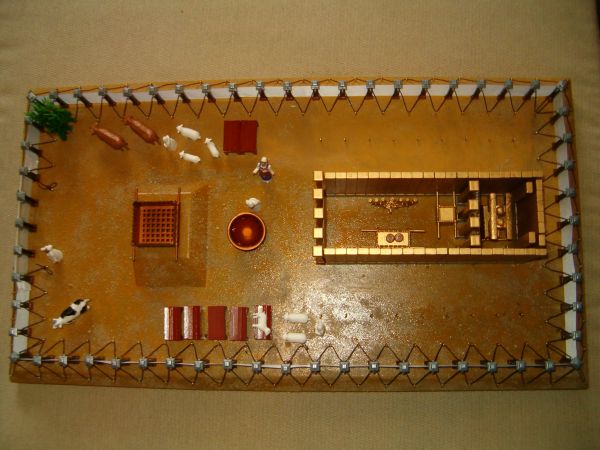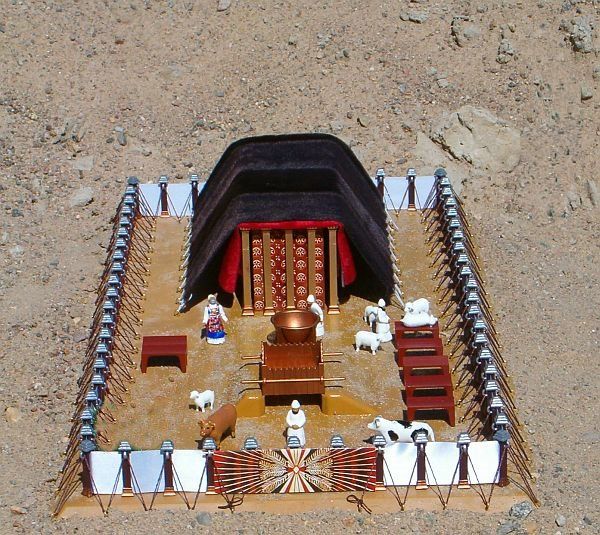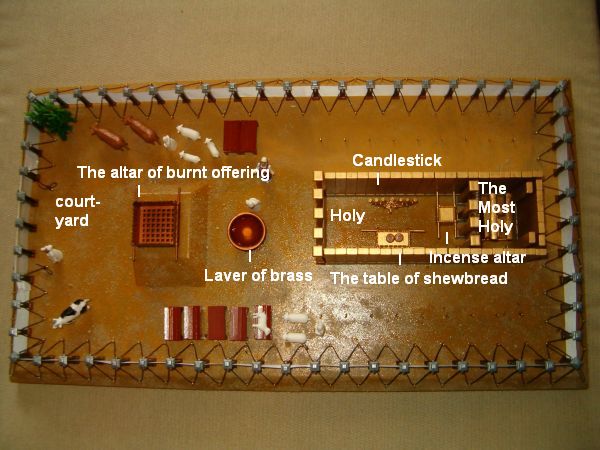The Tabernacle of Moses from its entrance to the its innermost room represents one’s progression in their spiritual journey starting with initial salvation progressing to the glorification of the physical body and eternal life in YHVH’s eternal spiritual kingdom.
Entering through the front door of the tabernacle and progressing to the holy of holies is from the human perspective as one moves toward Elohim; it is the perspective of moving from the human to the spiritual plane of existence or that of the earthbound looking heavenward. However, from YHVH Elohim’s view from the glory cloud that has hovering over the holy of holies just above the ark of the covenant, the perspective was different. It was from the inside looking out, or from heaven looking downward. We will discus the contrasting viewpoints between the human and divine in a moment.
In the outer court of the tabernacle, all the rituals and furnishings therein pointed to death and judgment, as well as to washing or cleansing. These prophetically foreshadowed salvation through Yeshua’s atoning death on the cross, with Yeshua being the door to salvation, and one’s need to accept his death on the cross for one’s sins followed by the need of baptism for the remission of sins.
In the set-apart (kadosh or holy) place inside the tabernacle, everything pointed to life, light, food, fragrant incense, the fruits and gifts of the Set-Apart Spirit—or life in a spiritual relationship with Elohim subsequent to one’s taking the beginning steps in the salvation process.
In summary, the outer court speaks of basic salvation for the redeemed believer in Yeshua, while the holy place speaks of spiritual growth and maturity, and of moving from spiritual babyhood and then growing into spiritual adulthood or maturity.
To understand this process of growing in spiritual maturity, it is necessary to comprehend the tripartite composition of the human being. Paul speaks of man being subdivided into three parts—body, soul and spirit (1 Thess 5:23). The tabernacle’s outer court seems to relate more to the physical or bodily realm of the person, while the holy place speaks more of the soul or intellectual, volitional and emotional aspects of one’s inner or psychological makeup. Finally, the holy of holies portrays man approaching YHVH through the realm of a person’s inner or personal spirit.
As one progresses into the tabernacle, it is as if YHVH is drawing a person into an ever deeper relational walk with him starting at the most basic level progressing upward until one is finally communing with YHVH on a Spirit-to-(human personal)-spirit level (in the most holy place). It is the Father’s desire that his children progressively grow until each of us is communing with him at the highest spiritual level (see John 4:23–24).
As noted earlier, this forward progression from the tabernacle’s entrance to its innermost room is but one way to view a person’s spiritual progression into the realm of the Spirit of Elohim. From YHVH’s perspective, looking from the inside of the tabernacle outward, the view changes. Although one has to enter the tabernacle through the outer gate and then go through various rites and rituals relating to a cleansing process before being allowed into the tabernacle itself, at the same time, we see YHVH starting to work with the person from the inside out. That is to say, when a person initially comes into a spiritual relationship with his Creator, YHVH first regenerates the person spiritually by putting his Set-Apart Spirit in the spirit of the person. In a sense, if the tabernacle is a picture of the tripartite subdivision of a person’s life (body, soul and spirit), then YHVH starts working from the inside out in one’s personal spirit, which is one’s personal holy of holies that is inside of them, if you will. From there, the Set-Apart Spirit goes to work on the person’s soul (mind, will and emotions) to transform it spiritually into the mind or image of Yeshua (Rom 8:28–29). This process will last a person’s lifetime. Finally, at the resurrection at Yeshua’s second coming, the saint’s will receive their redeemed and glorified or god-like body (1 John 3:1–2). At this time, they will become full-fledged, immortal spirit-children of Elohim (John 1:12). Though the Bible teaches that humans can become sons of Elohim and be like him as part of his divine family, man will never be equivalent to Elohim in a full sense (Isa 45:5, 6, 12, 18–19, 21–23). Only Elohim is the Creator, is without a beginning, and is all powerful, all knowing and all present. Man will never attain to this level.
The process of man going from being a physical and human creature to becoming an immortal and glorified child of the Most High, in theological terms, is called theosis, a Greek word meaning “deification or the act of becoming like deity.” This is an ancient Christian concept that is still held by the Eastern Orthodox Christian Church and refers to the spiritual process that occurs resulting in the deification of man. The goal of theosis is to become “like” (though not equal to) Elohim and to become eventually united with him spiritually. Theosis is the biblical concept of a redeemed or spiritually regenerated individual “becoming a partaker YHVH’s divine nature” (2 Pet 1:4), and being adopted into the family of Elohim (see the verses below). It is about man becoming like Elohim—becoming part of the family of Elohim as a child of Elohim (John 10:34; Ps 82:1; 1 John 3:1–3).
This is our theosis, that as the Ruach haKodesh (the Set-Apart or Holy Spirit) identified Yeshua as the Son of Elohim at his baptism, so we take the first steps of becoming a son of Elohim at our baptism when we become a new creation through Yeshua and the work of the Set-Apart Spirit (Gal 2:20; 2 Cor 5:17). At that time, one is begotten into the family of Elohim, and when one receives one’s glorified body at the resurrection one will be fully born or adopted into the family of Elohim as a full-fledged son of Elohim, for, as the Scripture says, we will be like him, for we will see him as he is (1 John 3:1–3).
Paul refers to theosis in several places when he uses the term adoption.
Continue reading






